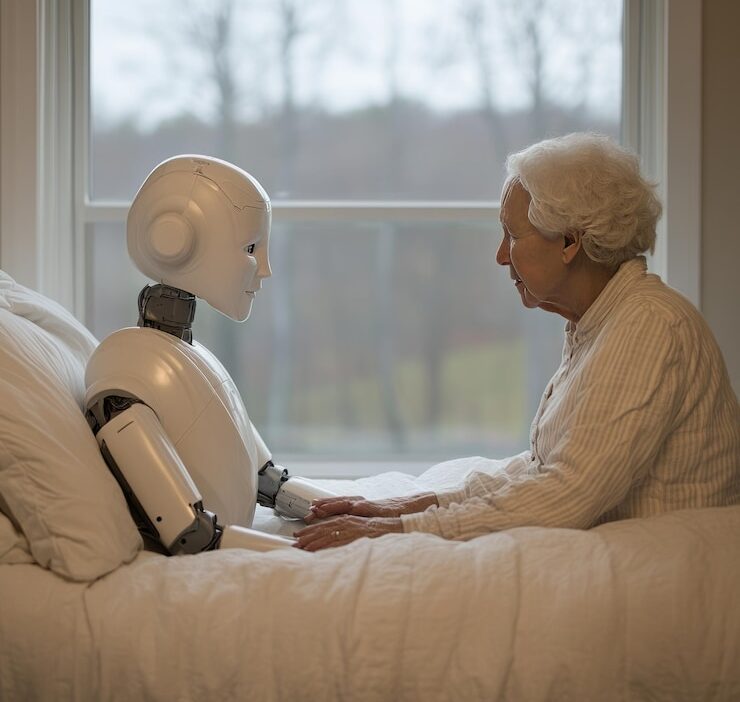Introduction
Home care services are rapidly developing in America as the aging population increases and the demands on managing chronic-care rises in the country. No longer do we just expect home care to provide basic support, since it also incorporates state-of-art artificial intelligence (AI). AI changes the way of care in-home as it makes it more safe, tracks vital signs, provides medicine reminders, and allows seeing virtual care, and at the same time increasing the efficiency of the caregivers.
This guide goes in depth into revealing the key role that AI can hold in home care services, providing an in-depth description of technology, advantages, real-life examples, challenges, the ethical aspect, and the future perspectives of AI-based home care services development, namely, in the USA.
1. The Importance of AI in Home Care Services
By definition, home care services refer to services that help individuals to manage health conditions, self-sustain, or become self-saints. These services can involve self-managing or becoming self-Jesus, self-perpetuating, or becoming self-saintly. The importance of AI in home care services can be discussed in detail as follows.
Demographic Shift: The U.S. census bureau predicts that one out of every 5 Americans will be aged 65 years or above by 2030. Technology at home is essential to maintain independence and safety at the home.
Labor Shortages: It is estimated that there will be more than 250,000 shortages of home health aides in 2028 by the Bureau of Labor Statistics. AI-based tools contribute to the scale-up of care without the loss of quality.
InCREASING CHARGES: AI helps to avoid careless hospitalization-lessening care expenses to the families and government spenders, such as Medicaid and Medicare.
2. Essential Artificial Intelligence to Drive Home Care
2.1 Intelligent Monitoring and Sensor System
Smart sensors detect movement levels or that of falls. When a particular person stands in one place too long or moves out of secure areas, they send alerts.
Pressure-sensitive sensors on bed and chairs record the presence and release of pressure that monitors time spent in a bed/chair to assist with fall prevention and sleep measurement.
2.2 Wearable Health Devices
AI algorithms are embedded in smartwatches and fitness trackers that measure the level of activity, heart rate variability, gait stability. They are usually fall-detection enabled.
Biosensing wearables have smart patches that constantly monitor blood pressure, glucose, respiratory rate, etc. providing real-time health information to the caregiver.
2.3 AI Voice and Conversation
With the help of voice assistants, such as Alexa, Healthcare devices, the elderly will also be able to request and receive support, reminders of their medicines, or simply call their caregivers with the natural language.
Artificial Intelligence companion as ElliQ or Jarvis facilitates interaction, cognitive engagement, and an emergency escalation after its activation.
2.4 Systems of Medication Management
Dispensers and smart pillboxes give a cue to the user to take medications on time and notify the caregivers of missed medications.
2.5 AI-Powered Triage Virtual Care Platforms
The use of natural language processors on telehealth platforms that support the use of symptom-checkers allows them to assess and prioritize the concerns of the patient, and provide recommendations on the appropriate care before consulting clinicians.
2.6 Engines of Predictive Analytics
Based on behavioral pattern analysis and sensor patterns, AI will already realize a health deterioration, e.g., an increased number of falls or a change in sleep quality or increases in a vital sign that can be addressed early on.
3. Advantages of AI-based Home Care Services
Safety and Peace of Mind
Since each year, 3 million older adults are visiting U.S. emergency rooms because of falls, AI instruments will be able to recognize falls or an immobile position, and inform a caregiver or emergency personnel.
Bigger Independence to the Elderly
The smart technology enables elderly people to remain safely in their own community without regular face-to-face contacts-creating a sense of dignity and postponing the inevitable placement in an institution.
Lowering of Readmissions in Hospitals
The ability to execute monitoring via AI assists in detecting early indicators of the flare-ups of chronic conditions, which promotes the approach of preventative care.
Cost and Time Saving
The idea of automating reminders, monitoring, and alerts implies a reduced number of manual check-ins, which allows the agencies to work with more clients due to an unchanged number of employees.
Personalized Care
AI algorithms can personalize reminders and routines and check-ins to the needs of the individuals and enhance adherence and outcomes.
Insights & Care Team Coordination
Dashboards consolidate health data– enabling families, clinicians and caregivers to monitor trends and make objective decisions.
4. Case Studies of the U.S. Home Care Services
4.1 Preventing Fall among the Personals
One of the home care agencies located in Texas introduced motion sensors and wearable fall detectors. They cut emergency hospitalization due to falls by 60 percent in more than 12 months.
4.2 Management of Chronic Disease
In Maryland, smart pills dispensers and AI-enabled continuous glucose monitors were applied among diabetic patients. The percentage of non-adherence was reduced to less than 10 per cent and there was a significant improvement of HbA1c.
4.3 Post Discharge Monitoring
A health system in California used voice-enabled tablets after being discharged. The outcome: 45 percent reduced COPD and heart failure readmissions within a 30-day span.
4.4 Home Based Mental Health Support
Cognitive engaging, virtual AI companions with human voice-like sounds were able to decrease the score of depression and loneliness in assisted-living people residing in New York.
5. Best Practices in Implementation of AI in Home Care
5.1 Begin by Care Needs Assessment
Judge on the conditions of individual clients, their mobility level, cognitive potential, and residence environment to choose the right AI tools.
5.2 Technology to be Client-Specific
Do not apply cookie-cutters, but instead add AI features according to different and individualized living situations, technology-savviness, and physical capabilities.
5.3 Training of Users
Conduct practical trainings to the older persons and family caregivers. Make the onboarding easier on a printout and a cheat-sheet.
5.4 Put in place Emergency Procedures
Characterize escalation workflows in case alerts or anomalies are met. Have family and 911 contacts stored in the devices and tracked by the caregivers.
5.5 Data Security and Privacy
Employ platforms compliant with HIPAA, those which are encrypted and which do not retain data that is unnecessary.
5.6 Iterate Again & Again
Restore data reviewed and alerts monthly. Modify thresholds or notifications by using the real world tendencies, as well as client feedback.
5.7 Care Teams Integration
Engage cloud dashboards or EMR integrations to make sure that physicians and care coordinators get to the appropriate health data promptly.
6. Dealing with Obstacles & Limitations
6.1 Resistence to Technology
Singular seniors might feel persecuted or onslaught by AI. We can advise implementing incremental technology adoption with the use of basic devices such as smart speakers.
6.2 Initial Cash OutX.
The cost of monitoring systems and wearables can be initially restrictive but ROI in terms of cost-effectiveness is high in preventing ER visits in the long-term.
6.3 Internet Problem
Wi-Fi/cellular connectivity in rural locations can be poor- use offline-capable modes and local synchronization of data.
6.4 Information Overload
Care managers can be overwhelmed without having proper filters and dashboards. Pay attention to the most important warnings and clear images.
6.5 Confidentiality and Ethics
Make sure that there is consent, data transparency and no unnecessary surveillance. Design devices in a dignified and autonomous respect.
7. In USA Regulatory & Reimbursement Environment
Some costs are offset by the possibility of Medicare reimbursement of remote patient monitoring codes, in conjunction with clinician review, e.g., CPT 99457.
In a number of states, Medicaid home- and community-based waivers permit supplemental technology funding on approved technology.
Other Medicare-eligible patients are encouraged to use RPM and prevention aids, and the number of private insurers that encourage such chronic-care management programs is growing.
8. Trends in the Future AI Powered Home Care
8.1 Background, Camera-less Surveillance
Non-video AI depth sensors and thermal flows can detect anomalies with high priority in relation to privacy.
8.2 Loneliness Indexing and Emotion Detection
The changes in tone and signs of loneliness will be more effectively identified by AI companions using the voice.
8.3 Robotics with Artificial Intelligence
It will be easier to get domestic robots that can deliver medications, guide mobility or even do simple tasks.
8.4 Predictive Interventions
Future algorithm-based risk oriented to imprisonment several months in advance, allowing actual illness prevention at home.
8.5 Approved AI AI Devices
Home AI medical devices to condition like heart failure or COPD are being approved by FDA.
9. The Best 5 Inquiries with Respect to AI-driven Home Care Services
Q1: Is it costly to have AI at home care?
The prices are different basic monitoring set up is 200-400 dollars one time plus 20-50 dollars/month. These expenses can be subsidized by Medicare/Medicaid. Avoided costs of hospitals and ERs are said to be part of the Return-on-investment.
Q2: Will humans caregivers be replaced by AI?
Not at all. AI supports human care = sustains routine monitoring and alerting, leaving caregivers free to build in-person emotional, therapeutic, and complex assistance.
Q3: Are AI surveillance systems safe in regard to privacy?
Trustworthy devices are HIPAA-compliant and are encrypted. They are also line with user acquiescence by offering facilities such as the mute room and sharing data features.
Q4: Does AI have the potential to spot heart attack or stroke in the home?
The currently available wearables are able to recognize unhealthy heartbeat, irregular heartbeat, or oxygenation. High-tech devices may be able to recognize the symptoms of impending stroke- yet a physician has to do it.
Q5: Do I require technology skills to be able to utilize these tools?
No. Setup is intuitive through user friendly voice interfaces, mobile applications and preconfigured devices. Caregiver training guarantees a smooth integration.
Conclusion
The revolution of home care services by incorporating the AI technology in the process is a paradigm change towards an in-home care that is safe, proactive, and individualized.
Throughout the USA, where older persons currently form the population majority and healthcare expenses keep rising, such tools have an astonishing potentiality of value especially filling in the blank spaces among real-time tracking, caregiver capacity, and preventive measures.
Fall detection sensors and AI companions, medication reminders, and predictive analytics, to mention a few, all help empower the capacity to live independently and with dignity. AI-powered home care is a potentially revolutionary aspect of contemporary care when it is promoted with care, training, and privacy awareness.





